Food Safety and Supply - Present and Future Challenges
Published: August 16, 2016
By: Patrick Wall
Professor of Public Health, University College Dublin, Ireland
With increasing liberalisation of trade and freer movement of goods, when it comes to trade in food, we are truly living in a global village. Increasing travel by citizens for tourism, business and emigration, combined with innovative marketing, has created a demand for a broad range of diets in many countries necessitating the importation of foods and ingredients as citizens wish to experience the tastes of far off cultures in their home countries, or wish for the taste of home in their new countries of residence.
Economies of scale and cheaper labor costs are giving some countries a competitive advantage in the global food market and many countries now find it more economic to import most of their food. However, free trade has to be safe trade emphasising the need for equivalent standards for all those players trading in the global market place. The longer the food chain, and the more players in the food chain, the more opportunities for things to go wrong or for criminal adulteration to occur with resulting adverse health consequences for consumers. One country’s problem can rapidly become another’s as contaminated product and ingredients can rapidly be disseminated. No country can afford to be complacent as they are only as secure as the standards of the weakest supplier from whom they import product, and a substandard domestic producer can put a nation’s citizens at risk and jeopardise a country’s reputation as a food exporter or as a tourist destination.
Furthermore a chronology of trade disrupting animal diseases from Food and Mouth disease to Avian flu have demonstrated that no country can claim to be immune to food scares. A contaminant can be imported as an ingredient for animal feed or human food, as has been seen with the BSE agent, Sudan 1 and Dioxin, and subsequently appear in home produced product. In this Global Village there is no room for arrogance, food control agencies, and industry stakeholders, must work, and respond, together and stigmatisation of one country will only serve to fuel consumer anxiety.
There are many food safety and supply chain associated challenges that have to be addressed and managed appropriately. These include:
- Meeting global demand for food
- Reducing global hunger
- International trade
- Tourism and travel
- Climate change – potable water for irrigation, new pests etc
- Ensuring sustainability of production systems
- Industrialisation of food industry
- Intensification of farming
- Securing income for farmers
- The evolution of the Common Agriculture policy post 2013
- Increasing sensitivity of laboratory analysis
- Balancing Benefits v Risks
- Consumer anxiety
- Obesity
- Food handler training:– “Your health is their hands”
- Competition between food and energy crops
- Risk associated with new technologies eg Nano
- Bioterrorism
Often the final product presented to the consumer can contain ingredients from several countries, and many manufacturers, making traceability and recall extremely difficult. For example a simple chicken Kiev can have ingredients from over 15 countries.
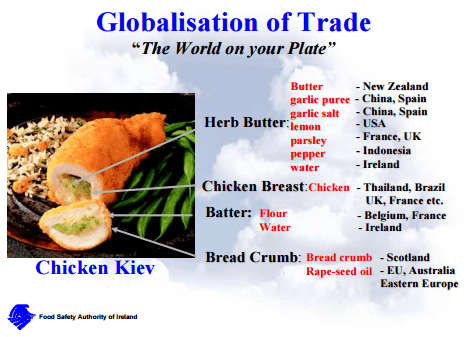
One ingredient can contaminate a range of products as happened with Chili powder adulterated with Sudan 1 which precipitated major recalls and consumer anxiety in the UK and further afield in February and March in 2005. The recall spread to several continents and international food maker Heinz recalled product sold in China. The analytical chemists are continuously improving the limits of detection and deciding what action to take at levels of parts per billion, or parts per trillion, is a major issue for risk managers but it is also a huge challenge for risk communicators operating, in a sound-byte dominated media, trying to explain to the public that “a genotoxic carcinogen is in their food but at levels “unlikely” to do them any harm!”
If food can travel rapidly throughout the world it is nothing to the speed at which information, or miss information, can travel with global news channels, satellite TV, the internet, and SMS. Good news, or more likely bad news, can be transmitted almost instantaneously. Electronic bulletins like “Google alert” keep food safety professionals and journalists also, abreast of the latest developments throughout the world with emerging news often complete with video clips being portrayed. Mobile phones with cameras, U tube, Twitter etc have created new media channels and citizen journalists ensure that no story can stay quiet for long.
Regularly the media is ahead of the risk managers and surveillance scientists, in highlighting a problem and many public health bodies monitor the global media as part of their early warning systems. Public perception is often informed by sensational news coverage and items are placed higher on the agenda of the policy makers as a result of the intensity of the media coverage of an issue.
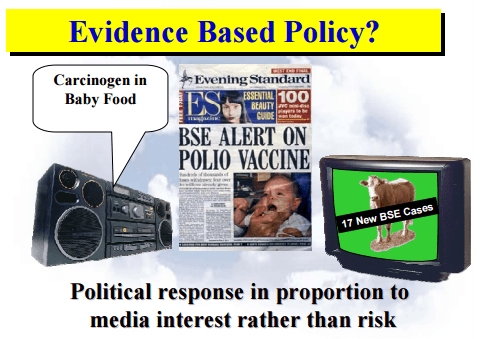
Public concern should rightly provide input into public policy but to derive meaningful policies via this route the public require accurate information presented in an understandable format. Herein lies the challenges for the policy makers to (1) effectively engage the public and (2) communicate risk in a two way dialogue.
The tendency toward panic reactions in response to catastrophic risks is something that should concern those involved in both industry and public health. The economic losses caused by overreaction, or misplaced reaction, can be huge, as can the loss of human life. For food companies it takes a lot of money to build a brand but it can be destroyed over night by a food scare or by being associated with human illness.
A risk management response in proportion to the media coverage of the issue rather than the actual risk to human health is not the ideal. Policy-makers and regulators are not consistent in how they address risk along the food chain and in society at large. Society does not treat equivalent risks with the same degree of intervention. For example, deaths from road traffic accidents are not regarded in the same way as deaths from food poisoning and do not precipitate the same degree of media coverage and reactionary risk management.
Those charged with overseeing food safety have to juggle many issues including public, health, science, consumer confidence, trade and politics. Effective communicating of risk is an essential component of their work if all these issues are to be aligned.
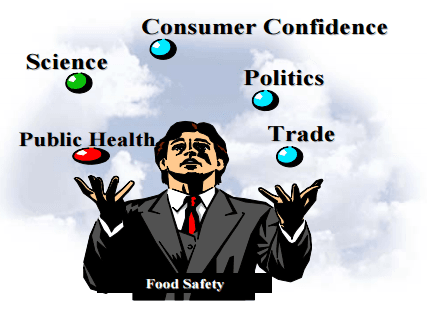
In most jurisdictions policing of the food chain could be improved as equal risks along the food chain do not receive the same amount of attention from the national inspectorate. Inspection frequency and intensity varies across the food chain ranging from some businesses having a permanent presence of inspectors to others being inspected annually or even less frequently. Some of this discrepancy results from legal requirements however it behoves countries to look at how they deploy the resources of their national inspectorates to deliver the most benefit in terms of consumer protection and protection of the food industry. Just like requesting a food business to undertake a HACCP analysis of their process the regulatory agencies should undertake a risk categorization of food and feed businesses along the entire food chain. Businesses should be categorized on the basis of:
a) Hazards associated with their raw ingredients
b) Hazards associated with the process
c) Hazard associated with their finished products
d) Food Safety Controls and management capabilities
e) Consequences of a major non compliance
Some food businesses are victims of their own success and outgrow their management capabilities and plant facilities posing a public health risk whereas, at the opposite end of the spectrum, others introduce requirements in excess of the legal requirements and subject themselves to third party audits. There is a move by the competent authorities from inspecting premises to auditing food safety management systems. The later satisfies the authorities that the food business has procedures in place to produce safe food on an ongoing basis whereas the former just gives a snapshot of how things are on the day of the visit. This move needs to be accelerated to ensure the activities of the national inspectorates are adding maximum value. One good systems audit can be much more effective than numerous inspections. The food chain is only as secure as its weakest link and there should be no gaps in the continuum of supervision from animal feed mills to the point of sale to consumers.
Attempting to recall ingredients, or product, from the global supply chain highlights that the concept of the food chain from farm to fork being a simple straight line
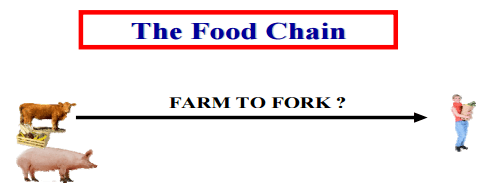
and the idea that it might be possible to put the name of the farm of origin on processed products are naïve in the extreme. The modern food chain is more like maize than a straight line with global sourcing of agrochemicals, pharmaceuticals minerals vitamins and animal feed at farm level.
Further along the chain many foods contain multiple ingredients often from many countries and even continents, routinely there is co-mingling of products from several processors in the finished food and in addition flavourings, additives and spices are routinely sourced from a global market place. Furthermore not all processors have the same standards and not all countries have the same controls or enforcement capabilities. Recalls, when ingredients are contaminated, whether they are spices, or larger components in processed products, are extremely difficult and costly. An inability to distinguish uncontaminated from contaminated food in the supply chain and market place often leads to the recall and destruction of large quantities of perfectly safe food and compounds consumer anxiety.
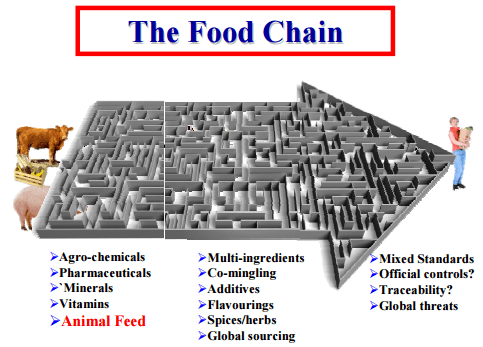
Further along the chain many foods contain multiple ingredients often from many countries and even continents, routinely there is co-mingling of products from several processors in the finished food and in addition flavourings, additives and spices are routinely sourced from a global market place. Furthermore not all processors have the same standards and not all countries have the same controls or enforcement capabilities. Recalls, when ingredients are contaminated, whether they are spices, or larger components in processed products, are extremely difficult and costly. An inability to distinguish uncontaminated from contaminated food in the supply chain and market place often leads to the recall and destruction of large quantities of perfectly safe food and compounds consumer anxiety.
We truly live in a global village and the health of citizens, and company brands, in one country are often dependent on the controls in operation in another so harmonisation and consistency are the name of the game. The problems we face in the modern food chain are similar in all jurisdictions and require global solutions with similar standards across the board and both good communication and collaboration between all national and international agencies.
All industry stakeholders need to step up to the plate as prevention is better than crisis management: - “Ask not what the regulators can do for you but what you can do for yourselves”.
While one third of the world is starving, another third is suffering from obesity and diet related disease. What constitutes a balanced diet is well documented but UK farmers need to defend there output which is both healthy and wholesome but can become vilified as meat and diary come under attack. Given the range of obesogenic products on display in every supermarket that have escaped the spotlight one would have to says that meat and dairy sector could do a better job of positioning their output in the eyes of the consumer.
With 1.1 billion people in the world hungry, reducing global hunger is a major challenge to be faced by global citizens. The world population of 6.5 billion in 2009 is set to grow to over 9 billion in 2050, increasing by the population of Germany each year. India and China have growing affluent middle and upper classes seeking a more western diet and premium foods so the demand for food will grow.
This forecast of increased demand for food rings hollow for many farmers who are currently producing product for close to the cost of production but “it all comes to those who wait” and the agrifood sector may be the spearhead of economic recovery as they are producing something that is essential for life. The volatility associated with world market commodity prices is not something that European farmers find easy to cope with making market support measures of some sort necessary by the EU to maintain some balance in the supply demand equation. The next phase of the EU Common Agriculture Policy is crucial for all EU Farmers not only those in the UK. The current uncertainty of how things will pan out is curtailing long term investments in the primary sector as even the most optimist risk takers need some idea of the likely rewards. Fortune favours the brave and primary producers are not short of courage.
More strategic alliances are necessary throughout the supply chain and an equitable distribution of margin is not an unreasonable aspiration if sustainability is to be achieved and issues like carbon footprints, environmental protection and animal welfare are to be addressed. The multiples have been great agents of change in the supply chain and have driven efficiencies and high standards into every sector but while they make a virtue out of fair trade coffee, and fair trade bananas, what about fair trade milk and fair trade beef.
Related topics
Authors:
Join to be able to comment.
Once you join Engormix, you will be able to participate in all content and forums.
* Required information
Would you like to discuss another topic? Create a new post to engage with experts in the community.
Create a post





.jpg&w=3840&q=75)